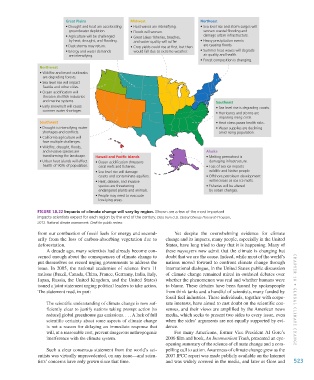Page 524 - Environment: The Science Behind the Stories
P. 524
Great Plains Midwest Northeast
• Drought and heat are accelerating • Heat waves are intensifying. • Sea level rise and storm surges will
groundwater depletion. • Floods will worsen. worsen coastal flooding and
• Agriculture will be challenged • Great Lakes fisheries, beaches, damage urban infrastructure.
by heat, drought, and flooding. and water quality will suffer. • Heavy precipitation events
• Dust storms may return. • Crop yields could rise at first, but then are causing floods.
• Energy and water demands would fall due to extreme weather. • Summer heat waves will degrade
are intensifying. air quality and health.
• Forest composition is changing.
Northwest
• Wildfire and insect outbreaks
are degrading forests.
• Sea level rise will impact
Seattle and other cities.
• Ocean acidification will
threaten shellfish industries
and marine systems. Southeast
• Early snowmelt will cause • Sea level rise is degrading coasts.
summer water shortages.
• Hurricanes and storms are
imposing rising costs.
Southwest • Heat stress poses health risks.
• Drought is intensifying water • Water supplies are declining
shortages and conflicts. amid rising population.
• California agriculture will
face multiple challenges.
• Wildfire, drought, floods,
and invasive species are Alaska
transforming the landscape. Hawaii and Pacific Islands • Melting permafrost is
• Urban heat islands will affect • Ocean acidification threatens damaging infrastructure.
health of 90% of population. coral reefs and fisheries. • Loss of sea ice impacts
• Sea level rise will damage wildlife and Native people.
coasts and contaminate aquifers. • Offshore petroleum development
• Heat, disease, and invasive will increase as sea ice melts.
species are threatening • Fisheries will be altered
endangered plants and animals. by ocean changes.
• People may need to evacuate
low-lying areas.
Figure 18.22 Impacts of climate change will vary by region. Shown are a few of the most important
impacts scientists expect for each region by the end of the century. Data from U.S. Global Change Research Program,
2013. National climate assessment. Draft for public review.
from our combustion of fossil fuels for energy and second- Yet despite the overwhelming evidence for climate
arily from the loss of carbon-absorbing vegetation due to change and its impacts, many people, especially in the United
deforestation. States, have long tried to deny that it is happening. Many of
A decade ago, many scientists had already become con- these naysayers now admit that the climate is changing but
cerned enough about the consequences of climate change to doubt that we are the cause. Indeed, while most of the world’s
put themselves on record urging governments to address the nations moved forward to confront climate change through
issue. In 2005, the national academies of science from 11 international dialogue, in the United States public discussion
nations (Brazil, Canada, China, France, Germany, India, Italy, of climate change remained mired in outdated debates over
Japan, Russia, the United Kingdom, and the United States) whether the phenomenon was real and whether humans were
issued a joint statement urging political leaders to take action. to blame. These debates have been fanned by spokespeople
The statement read, in part: from think tanks and a handful of scientists, many funded by
fossil fuel industries. These individuals, together with corpo-
The scientific understanding of climate change is now suf- rate interests, have aimed to cast doubt on the scientific con- CHAPTER 18 • Glob al Cli M aT e Chan G e
ficiently clear to justify nations taking prompt action [to sensus, and their views are amplified by the American news
reduce] global greenhouse gas emissions. . . . A lack of full media, which seeks to present two sides to every issue, even
scientific certainty about some aspects of climate change when the sides’ arguments are not equally supported by evi-
is not a reason for delaying an immediate response that dence.
will, at a reasonable cost, prevent dangerous anthropogenic For many Americans, former Vice President Al Gore’s
interference with the climate system. 2006 film and book, An Inconvenient Truth, presented an eye-
opening summary of the science of climate change and a com-
Such a clear consensus statement from the world’s sci- pelling call to action. Awareness of climate change grew as the
entists was virtually unprecedented, on any issue—and scien- 2007 IPCC report was made publicly available on the Internet
tists’ concerns have only grown since that time. and was widely covered in the media, and later as Gore and 523
M18_WITH7428_05_SE_C18.indd 523 12/12/14 4:05 PM

